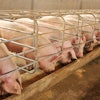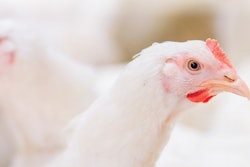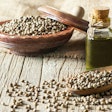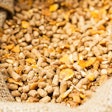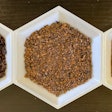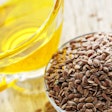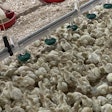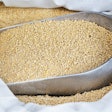
Phytogenic feed additives, or plant-derived products used in animal feed to improve performance, represent one possible feed additive to include in new feeding regimens while reducing antibiotic reliance in animal protein production. Antimicrobial resistance (AMR) has only increased in relevance in recent years, and phytogenics are solid contender for substituting antibiotic use.
During her talk at the Feed Strategy Seminar, held at Health & Nutrition Asia (HNA), Dr. Sabiha Kadari, the regional technical director SEAP at EW Nutrition, proposed that phytogenics are crucial to supporting an antibiotic reduction (ABR) strategy. Phytogenics can help step in for gut health and performance optimization when administering fewer antibiotic growth promoters (APGs).
"The important thing to note is that nearly 20 to 25% of the body's expenditure is from the gut. So, in that case, if the gut health is deteriorated, you can imagine the energy expenditure. ... When the bird is expending most of its energy keeping its gut health, it is not able to maintain its performance or use that energy to meet its production parameters."
Phytogenic additives may include essential oils, an oily liquid extract derived from various plants, that contain phytomolecules, as well as raw plant matter, which can also be included in feeding regimens. Essential oils and phytomolecules are mainly used to control bacteria populations, and can also be administered through water with liquid phytomolecule preparations.
Kadari’s research shows phytogenics were used at least twice as much as yeast, butyric acid, direct-fed microbials and enzymes in 2021 no-antibiotic-ever (NAE) programs.
 Dr. Sabiha Kadari, regional technical director - SEAP at EW Nutrition, presents at the Feed Strategy Seminar, held in Bangkok on March 13, 2024.Jackie Roembke
Dr. Sabiha Kadari, regional technical director - SEAP at EW Nutrition, presents at the Feed Strategy Seminar, held in Bangkok on March 13, 2024.Jackie Roembke
Phytogenics and poultry digestive tracts
Kadari specified in her presentation that poultry in particular have very complex digestive systems, with the gut being the largest immune organ in their bodies and home to about 640 different species of bacteria. Even with this complex system, phytogenics pose a solution with reducing antibiotic use. She focused on three factors in poultry health related to the gastrointestinal tract, with “balance of gut microbiota, the integrity of the gut lining, and the ability to digest and absorb nutrients available in feed” being most significant.
"There isn't a single given factor" affecting poultry health, she said. "It's a combination of various factors."
Adding phytogenics to feeding regimen
Like related research into the reduction of antibiotic use, Kadari stipulates that simply throwing phytogenics into feed, either through essential oils or raw plant matter, will not entirely substitute for APGs. Considerations for water quality, litter management, stress and more is just important as what the animals eat. The environment in which animals live must be clean and comfortable in order for an ABR strategy to reach its full potential. Kadari suggests, for example, the use of a proprietary blend of the best phytomolecule candidates possible, with the chosen compounds addressing the mitigation of target pathogens through antimicrobial properties, preventing formation and stress via antioxidant properties, and moderating the immune system with anti-inflammatory properties.
"We are suppliers trying to come up with solutions which can address these challenges," she said, and phytogenics may be one of them.
It seems that phytogenic research is most often conducted with poultry, though it also has shown promising results with swine and in both dairy and beef cattle. Phytogenics are a promising option when considering reducing the use of APGs for producers, and point to a newly fashionable feed additive on the near horizon.
Editor's note: The 2024 edition of Health & Nutrition Asia was co-located with VICTAM Asia in Bangkok, Thailand, March 12-14, 2024.


